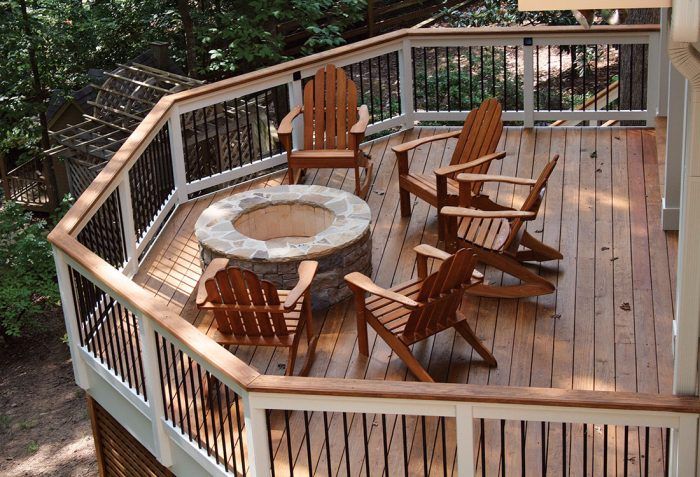First-Story Decks
These 13 welcoming decks are ideal for entertaining–or a quiet moment alone.

A deck attached to the first-story kitchen or great room is probably the most common type of deck. Tied into the rim joist just above the foundation, it is easy to frame up and attach—an ideal arrangement for the do-it-yourselfer. These decks require a railing if more than 30 in. above grade, unless they incorporate cascading levels like those shown in the photo below. The railing is primarily a safety feature, but it also provides an opportunity to pack some style into your deck.
Stairs are another element that offers attractive design possibilities. While stairs a minimum of 36 in. wide are accepted by most codes, 48 in. is more comfortable for people to pass each other. Going even wider offers a more visible transition to grade level and provides overflow seating when you need it. Wide stairs also offer enticing possibilities for incorporating planters and lighting.
A) This first-story deck is close enough to grade to support a deep masonry fire pit. A tubular baluster railing preserves the view.

B) If mega entertaining is your forte, consider the benefits of cascading levels for informal seating. Coupled with standard-stride stairs, the multiple levels look great empty or occupied by a cast of your favorite people.

C) Although the deck is a relatively modern innovation, careful styling can meld it with a traditional home. With attention to the scale of the posts, fascia, and pergola, this deck has timeless appeal.

D) This elegant little pocket deck is a perfect spot for morning coffee or an evening drink, proving that for some situations bigger is not best.

E) Gentle curves ease this PVC deck into the landscape. Pergolas come in handy for defining the entryway and framing the dining area. To extend deck enjoyment into the autumn, add curtains to buffer the prevailing wind. A propane heater warms the lounging area.

F) Even a modest-sized single-story deck can pack in all the features you want. From a privacy screen to an inset graphic, this PVC deck has a stunning array of great ideas worth incorporating into your own design.

G) This traditionally styled deck is designed for effective traffic flow. A lower level welcomes guests from the front of the house. The grill is close to the kitchen, and the dining area is pleasantly tucked into a corner.

H) On the principle that nature doesn’t love square corners, this deck is all curves. Radius railings and deck edging require pros who are equipped to heat-bend synthetic decking. The result is a showpiece deck.

I) By wrapping the angle-joined framing with synthetic fascia before adding the posts, this deck achieves the beauty of a radius without any heat bending. Ornamental metal balusters accentuate the effect.

J) Think beyond the deck itself and consider its context. Beckoning elements, like stairs leading to a patio path, add drama and interest. Because this house is sited on a hill, there is room for shaded outdoor space under the screened porch.

K) With all the charm of a front porch, this backyard deck packs in amenities like a fireplace, grilling area, and even a big-screen TV. Located in a region where shade makes outdoor living possible, this deck has an all-encompassing roof.

L) Wide stairs add a lot of drama and are spacious enough to provide informal seating when needed. A balcony equipped with matching railing helps meld the deck to the house.

M) Dedicated to dining, this compact deck combines with a screened porch, an outdoor alternative during the buggy parts of the summer. This addition demonstrates that screening the area underneath the deck isn’t always necessary.
Other types of decks
Grade-Level Decks – Low-lying decks provide an easy transition from house to landscape.
Second-Story Decks – Elevated decks help tame a sloped lot.
Fine Homebuilding Recommended Products
Fine Homebuilding receives a commission for items purchased through links on this site, including Amazon Associates and other affiliate advertising programs.

A House Needs to Breathe...Or Does It?: An Introduction to Building Science

MicroFoam Nitrile Coated Work Gloves

All New Kitchen Ideas that Work





